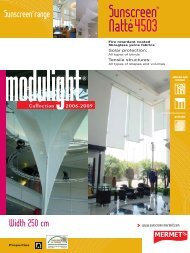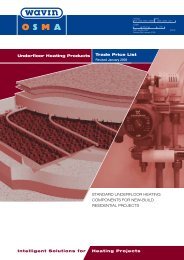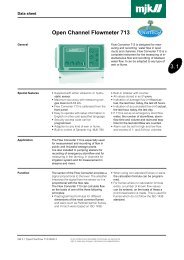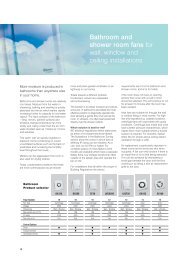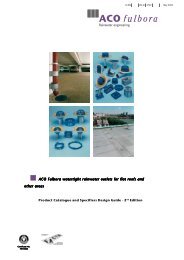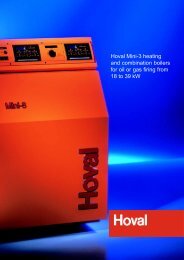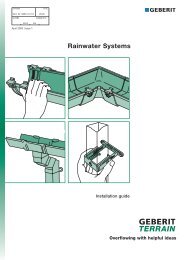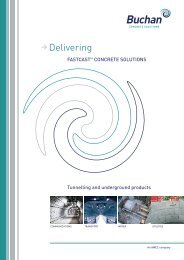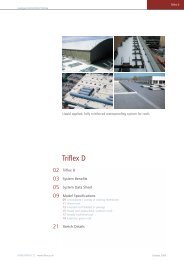Imax condensing boilers - CMS
Imax condensing boilers - CMS
Imax condensing boilers - CMS
Create successful ePaper yourself
Turn your PDF publications into a flip-book with our unique Google optimized e-Paper software.
6<br />
product specification<br />
Performance<br />
The Ideal range offers high operating efficiencies,<br />
together with the lowest possible emissions, and is certified to<br />
comply with the Gas Appliance Directive (90/396) and the Boiler<br />
Efficiency Directive (92/42), the European Directives governing<br />
safety and performance of gas <strong>boilers</strong> ensuring high quality<br />
performance.<br />
The design of the boiler ensures high efficiencies at both full<br />
and part loads to meet the new ‘Building Regulations 2000’<br />
conservation of fuel and power. Approved efficiencies are up to 98%<br />
at 80˚C flow based on net calorific value of fuel (88.5% gross) at full<br />
load. At 30% part load the efficiencies exceed 108% net (97.3%<br />
gross).<br />
Boiler Range Certificate No. Notified Body Reference<br />
W W45 - 80 0063BN3218I Gastec NV 0063<br />
Plus F80 - 280 49BM3615 AFNOR, Paris 0049<br />
In order to give you assurance and peace of mind a Certification of<br />
Compliance to the Building Regulations 2000 can be obtained from<br />
the commercial heating department.<br />
Boiler Operation<br />
W<br />
On a call for heat, air is drawn into the boiler variable speed fan.<br />
The fan inlet incorporates a special mixing arrangement for gas<br />
supplied from the gas valve. The gas/air mixture is automatically<br />
ignited at low rate beneath the burner via a spark electrode and<br />
ignition proved by a flame rectification electrode. The flue gases pass<br />
downwards through the heat exchanger and via the sump and flue<br />
outlet to atmosphere. A plume of vapour will be visible at the<br />
terminal due to the low exit temperature.<br />
The boiler modulates its output according to demand via the<br />
flow/return sensors and any external controls. The fan speed and gas<br />
flow are adjusted under this electronic control to provide the correct<br />
mixture and output. This maintains high efficiency part loads.<br />
Condensation within the boiler will start to occur when the<br />
return temperature is below the dew point (55˚C). The flue gases will<br />
condense and increase boiler efficiency by giving up their latent heat<br />
to the system. Condensation formed within the boiler is removed via<br />
the integral drain.<br />
Plus<br />
When the boiler receives a call for heat, the boiler control<br />
Modular Boiler Drive (MBD) calculates the necessary output<br />
according to the difference between the set flow temperature (or<br />
compensated flow temperature for a CH call when using an outside<br />
sensor) and the boiler modules’ combined flow temperature. The first<br />
module fan operates and the gas/air mixture is automatically ignited<br />
below the burner via a spark electrode and proved by a detection<br />
electrode. Ignition occurs in 5 seconds and once detected the<br />
module starts operating. Subsequently, additional modules will fire<br />
to provide the load required.<br />
The boiler principle method of operation is to run as many<br />
modules simultaneously, at the lowest possible load, for maximum<br />
efficiency e.g.<br />
If an F160 with 160kW max. output is only requested to provide<br />
72kW.<br />
72 / 4 = 18kW per module<br />
Therefore, the boiler operates all modules at the reduced rate of<br />
18kW. If the required load is less than the min. 12kW per module,<br />
then one module after the other will automatically shut down and the<br />
load shared by the remaining modules. The modules with the lowest<br />
number of hours run are automatically chosen to satisfy the demand.<br />
Electrical Controls<br />
The <strong>boilers</strong> incorporate an advanced microprocessor based<br />
control system which operates all electrical functions of the boiler<br />
including ignition, flame detection, flow/return temperature sensors<br />
and output modulation. In addition the microprocessor displays<br />
boiler status and a fault diagnosis program.



